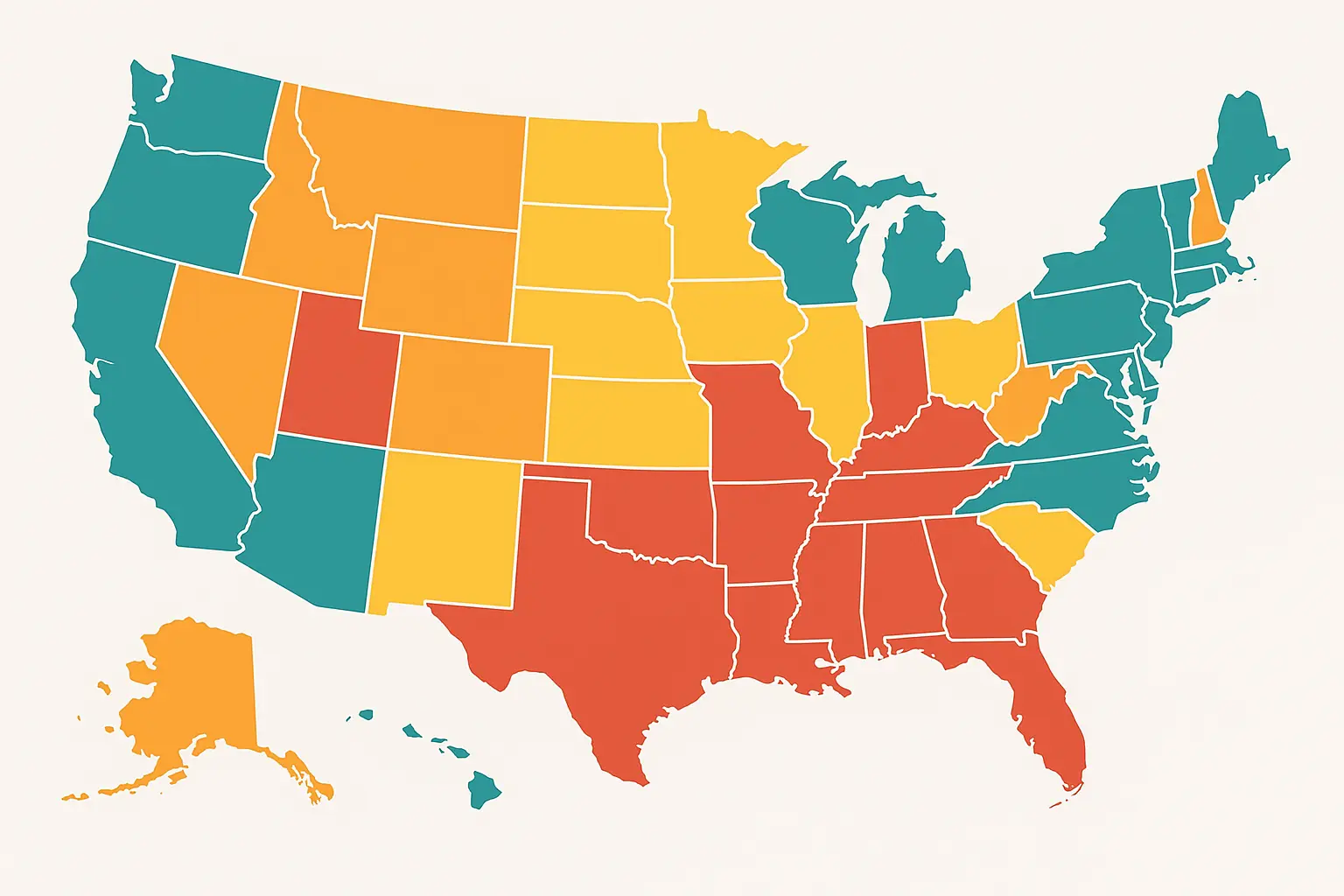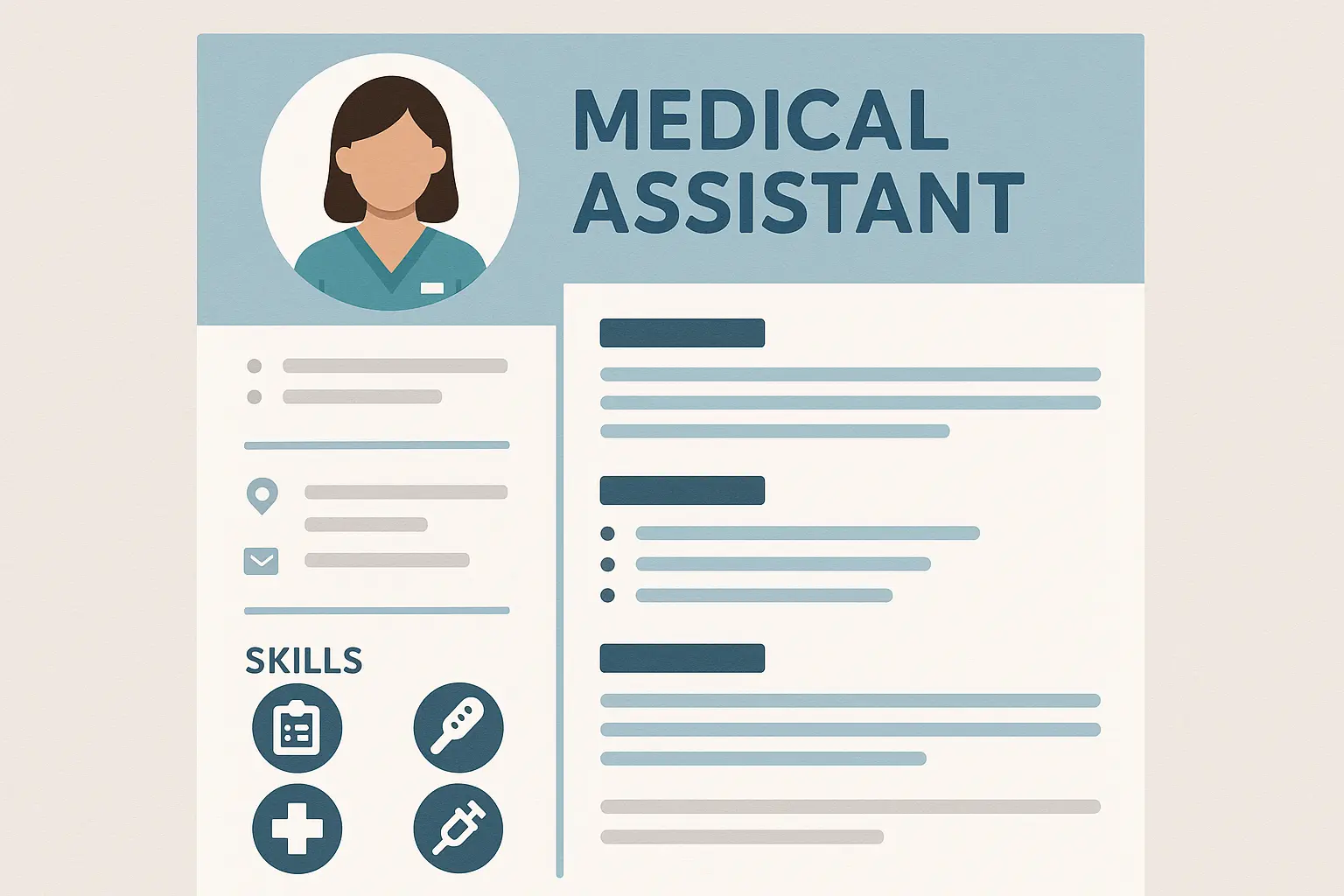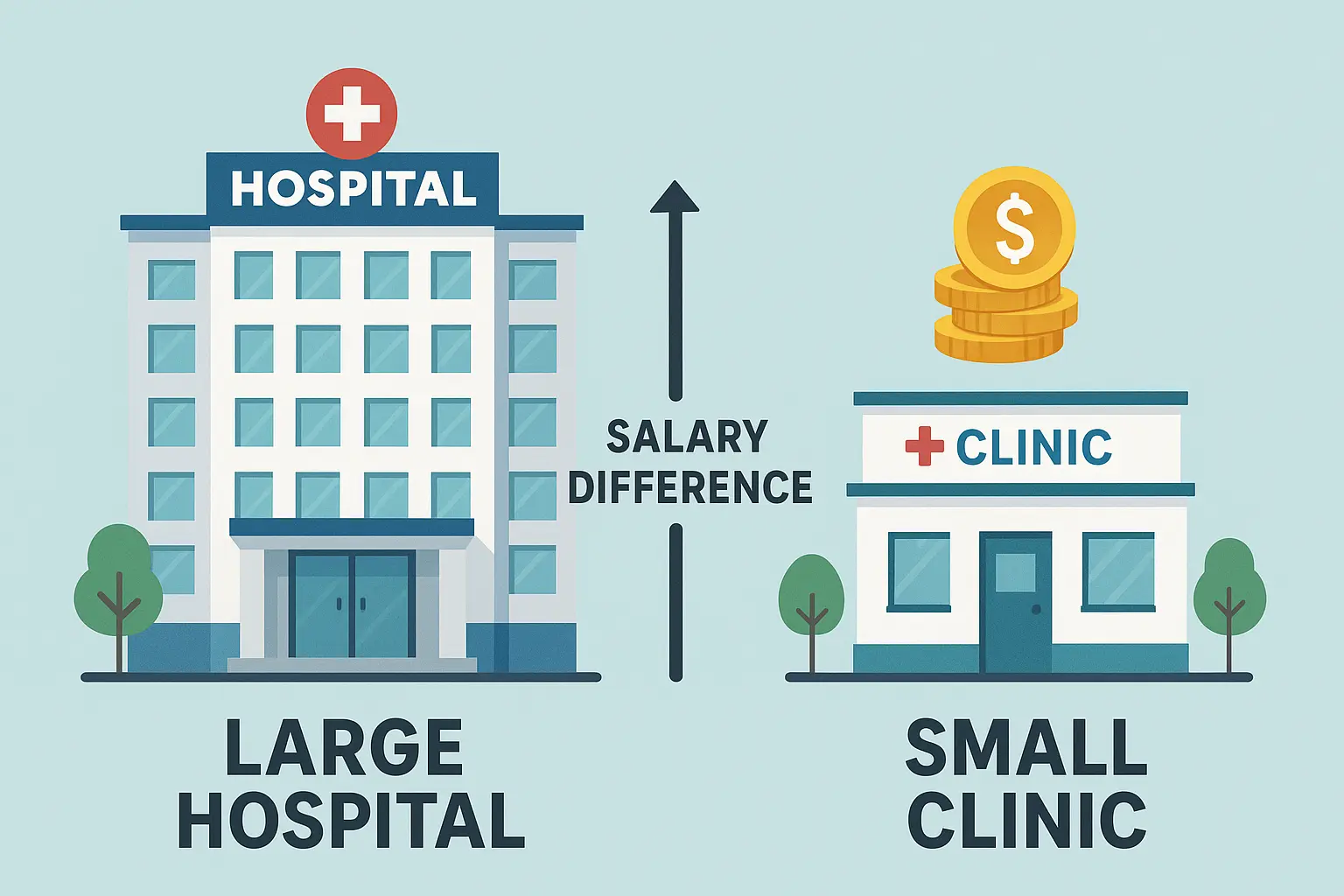The Medical Assistant Salary Guide That Actually Tells You the Truth

Look, I’m going to be straight with you. After years in healthcare, I’ve watched too many medical assistants settle for whatever salary they’re offered, not knowing they could be earning thousands more.
The reality? Some of your colleagues are pulling in $20,000+ more than you for doing the same work. And it’s not because they’re lucky or connected – they just know things you don’t.
With nearly 765,000 medical assistants working nationwide and job growth exploding, there’s never been a better time to figure out how to maximize your paycheck. Let me show you exactly how.
Cut to the Chase: What You Really Want to Know
Starting out? Expect $28,000-$35,000, but don’t stay there long.
Been around a few years? You should be hitting $48,000+ if you’re playing your cards right.
Get your CMA certification. It’s worth an extra $3,000-$6,000 annually. Period.
Hospital vs. private practice? Hospitals pay 15-25% more. Do the math.
Location matters – a lot. San Francisco, Seattle, Boston. Yes, they’re expensive, but the salary bump often makes it worth it.
Specialty practices are where the real money is. Cardiology, dermatology, orthopedics? They pay 15-30% more than family medicine.
Why Your Paycheck Might Be Smaller Than It Should Be
Here’s what most people don’t realize: the medical assistant field has completely transformed. We’re not just scheduling appointments and filing papers anymore. You’re doing clinical work, managing complex systems, and keeping entire practices running smoothly.
But many employers (and honestly, many medical assistants) are still stuck thinking about compensation like it’s 2010.
Location: Your Secret Weapon (Or Your Biggest Mistake)
I can’t stress this enough – where you work changes everything. And I’m not just talking about obvious places like New York or California.
Take Sarah from Denver. She was making $38,000 at a small family practice. When she moved to a major hospital system in the same city, her salary jumped to $47,500 overnight. Same skills, same experience, different employer type.
The cities that actually pay:
San Francisco leads the pack for medical assistant compensation, followed closely by Seattle and Boston. These metropolitan areas provide comprehensive benefit packages and advancement opportunities that can accelerate your entire career trajectory. The premium you’ll earn often more than compensates for higher living costs.
|
Metropolitan Area |
Average Annual Salary |
Cost of Living Index |
Net Purchasing Power |
|---|---|---|---|
|
San Francisco, CA |
$52,800 |
164.0 |
High |
|
Seattle, WA |
$49,200 |
172.3 |
Moderate |
|
Boston, MA |
$47,600 |
149.7 |
High |
|
New York, NY |
$46,800 |
187.2 |
Moderate |
|
Los Angeles, CA |
$44,900 |
173.3 |
Moderate |
But here’s the thing – you don’t always have to move to a big city. Sometimes it’s about finding the right type of employer in your current area.
State-by-State Reality Check
Alaska, California, and Massachusetts consistently top the charts for medical assistant wages, while southern and rural states typically offer lower base compensation. However, the cost-of-living equation isn’t always straightforward. Some lower-paying states provide better purchasing power and quality of life ratios that savvy professionals leverage.
Medical assistants who understand these state-level differences can make strategic moves that dramatically improve their financial situations. I’ve watched professionals double their effective purchasing power by choosing the right geographic markets.
Hospital vs. Private Practice: The Real Story
Hospitals consistently pay more. But it’s not just about the base salary:
-
Better benefits packages
-
Overtime opportunities
-
Shift differentials for evenings/weekends
-
Tuition reimbursement
-
Clear advancement paths
Private practices offer other perks – closer patient relationships, more flexibility, less bureaucracy. But if maximizing your paycheck is the goal, hospitals win.
Research shows that 56% of medical assistants work in doctors’ offices, while 15% work in hospitals, 9% in outpatient care centers, and 8% in offices of other healthcare providers. Each setting offers distinct advantages and compensation structures that smart professionals evaluate carefully.
Hospital-employed medical assistants typically earn 15-25% more than their private practice counterparts, plus they get access to benefits that smaller practices cannot match. Large healthcare systems offer structured career advancement paths, tuition reimbursement, and comprehensive health coverage.
The Specialty Practice Gold Mine
This is where things get interesting. Specialty practices need medical assistants with specific skills, and they pay for that expertise.
Medical assistants working in specialized practices command 15-30% salary premiums over general family medicine positions. These roles require additional skills and knowledge, but the investment in specialized training pays dividends throughout your career.
|
Specialty Practice |
Average Annual Salary |
Premium vs. Family Medicine |
Required Additional Skills |
|---|---|---|---|
|
Podiatry |
$57,000 |
+35% |
Foot care, specialized equipment |
|
Ophthalmology |
$50,000 |
+25% |
Eye exams, vision testing |
|
Cardiology |
$45,760 |
+18% |
EKG, stress testing |
|
Dermatology |
$41,600 |
+12% |
Skin procedures, biopsy assistance |
|
Family Medicine |
$38,800 |
Baseline |
General clinical skills |
The catch? You need additional training. But here’s the secret: most of these skills aren’t that hard to learn, and the return on investment is incredible.
How to Actually Increase Your Salary (Beyond Just Showing Up)
Multiple factors influence medical assistant compensation beyond just showing up to work. Geographic location remains the biggest variable, but healthcare setting, employer size, and individual qualifications create significant earning opportunities for those who understand the system.
Smart professionals leverage these factors strategically. They don’t just accept whatever salary is offered; they position themselves to maximize every compensation variable within their control.
Certification: Your Best Investment
I know, I know. Another certification, more studying, more fees. But listen to this:
Marcus in Phoenix spent $1,200 on CMA certification preparation and exam fees. Six months later, he negotiated a $4,800 raise and got promoted to lead medical assistant. That’s a 400% return on investment in less than a year.
Industry data shows that 88% of employers encourage or require certification for medical assistants, and being certified can increase salary by as much as 10%. Additionally, 56% of healthcare institutions pay certified employees more than their uncertified counterparts.
Professional certifications provide direct pathways to higher compensation. CMA certification alone typically adds $3,000-$6,000 annually, while specialized credentials can boost your earning potential even further. The investment in certification pays for itself quickly.
Worth your time and money:
Beyond basic CMA certification, specialized credentials in medical coding (CPC), phlebotomy, or medical office administration significantly boost earning potential and job security. These certifications open doors to specialized roles and premium compensation.
When pursuing additional healthcare certifications, understanding related salary benchmarks is crucial – exploring phlebotomist salary insights can help you evaluate whether dual certification makes financial sense for your career path.
Medical Assistant Certification Checklist:
-
Research state-specific certification requirements
-
Choose between CMA, RMA, NCMA, or CCMA credentials
-
Complete accredited medical assistant program
-
Schedule and pass certification exam
-
Maintain continuing education requirements
-
Update resume and LinkedIn profile with new credentials
-
Negotiate salary increase with current employer or apply for higher-paying positions
The Negotiation Conversation That Actually Works
Forget asking for a raise because you “deserve it” or because you’ve been there a year. That doesn’t work.
Here’s what does work:
Before the conversation:
-
Document everything – patient volume, efficiency improvements, additional responsibilities
-
Research what others in your area are making (use real data)
-
Prepare specific examples of how you’ve saved the practice money or improved operations
Before entering salary negotiations, it’s essential to understand proven strategies – our comprehensive guide on how to ask for a raise effectively provides the framework that medical assistants use to secure significant pay increases.
During the conversation:
-
Lead with your value, not your needs
-
Have specific numbers ready
-
Be prepared to discuss the whole compensation package, not just base salary
Jennifer did this perfectly. She documented that she processed 15% more patients than average while maintaining 98% patient satisfaction. She researched local salary data and found she was $3,000 below market rate. Result? $5,200 raise plus professional development funding.
Benefits Package Evaluation Beyond Base Salary
Total compensation includes health insurance, retirement contributions, paid time off, and professional development opportunities. Understanding the complete value proposition helps you make informed decisions when comparing job offers and negotiating packages.
Sometimes a lower base salary with excellent benefits provides better total compensation than a higher salary with minimal benefits.
Salary Negotiation Preparation Template:
1. Market Research Phase:
-
Current local salary ranges: $_______ to $_______
-
Industry average for your experience level: $_______
-
Specialty practice premium (if applicable): $_______
2. Performance Documentation:
-
Patient volume handled monthly: _______
-
Efficiency improvements implemented: _______
-
Additional responsibilities taken on: _______
-
Patient satisfaction scores: _______%
3. Value Proposition:
-
Cost savings generated: $_______
-
Revenue increases attributed to your work: $_______
-
Training/mentoring provided to colleagues: _______
4. Negotiation Goals:
-
Target salary increase: $_______
-
Alternative benefits if salary is fixed: _______
-
Professional development requests: _______
Building Your Professional Brand for Higher Pay
Here’s something most medical assistants never think about: you need to become known for something specific. The highest-paid MAs aren’t just good at their jobs – they’re the go-to person for something valuable.
Maybe you’re the one who can calm down anxious patients. Maybe you’re incredibly efficient with insurance verifications. Maybe you train new hires better than anyone else. Whatever it is, document it and make sure people know about it.
Creating a strong professional presence demonstrates your value to potential employers and justifies higher compensation requests. This involves systematically documenting achievements, quantifying your impact, and positioning yourself as an indispensable team member.
Track everything that matters:
-
How many patients you see per day vs. department average
-
Patient satisfaction scores
-
Process improvements you’ve suggested
-
Money you’ve saved the practice
-
Times you’ve covered for colleagues or taken on extra responsibilities
When review time comes around, you won’t be saying “I work hard.” You’ll be saying “I processed 200 more patients than the department average while maintaining a 96% satisfaction score, and my insurance verification process reduced claim denials by 15%.”
That’s the difference between a 2% cost-of-living raise and a real salary increase.
Medical assistants who maintain detailed records of their achievements create powerful negotiating tools. When you can show exactly how your work saves money or improves efficiency, employers recognize your worth through increased compensation.
Landing Higher-Paying Positions: Resume Strategy That Works
Your resume is probably getting filtered out by software before any human sees it. Healthcare employers use applicant tracking systems (ATS) that scan for specific keywords and formatting.
Your resume serves as your primary tool for accessing higher-paying medical assistant opportunities. Healthcare employers increasingly use applicant tracking systems to screen candidates, making strategic formatting crucial. The right positioning can mean the difference between getting interviews and being overlooked entirely.
Creating a standout medical assistant resume requires understanding industry-specific formatting requirements – our detailed medical assistant resume examples showcase proven templates that help candidates secure interviews for higher-paying positions.
ATS-friendly basics:
-
Use standard headings (Experience, Education, Skills)
-
Include certification acronyms (CMA, RMA, CCMA)
-
Mirror language from job postings
-
Save in both PDF and Word formats
-
Use bullet points, not paragraphs
To maximize your resume’s effectiveness with applicant tracking systems, understanding ATS-friendly resume formatting is crucial for medical assistants competing for premium salary positions.
What gets attention:
-
Numbers and metrics in every bullet point
-
Progression in responsibilities
-
Specific clinical skills (phlebotomy, EKG, injections)
-
Software proficiency (EMR systems, scheduling platforms)
-
Patient volume handled
Instead of: “Responsible for patient care”
Write: “Managed care for 40+ patients daily, including vital signs, medication administration, and patient education, maintaining 98% satisfaction scores”
The second version tells a story about your capability and impact.
ATS-Optimized Resume Checklist:
-
Include relevant medical assistant keywords from job postings
-
Use standard section headings (Experience, Education, Skills)
-
Save resume in both PDF and Word formats
-
Include certification acronyms (CMA, RMA, CCMA)
-
Quantify achievements with specific numbers
-
Use bullet points instead of paragraphs
-
Include both technical and soft skills
-
Proofread for spelling and grammar errors
Resume Builder IQ understands the unique challenges medical assistants face when positioning themselves for higher-paying opportunities. Our AI-powered platform creates ATS-optimized resumes that highlight salary-boosting qualifications and help you secure those premium positions. With medical assistants earning 23% more interviews using professional resume builders, we provide the competitive edge you need to command the salary you deserve.
Making the Jump: When and How to Change Jobs
Sometimes the biggest salary increases come from switching employers, not negotiating with your current one. But timing and strategy matter.
Signs it’s time to move:
-
You’ve been in the same role for 2+ years without significant salary growth
-
You’ve maxed out advancement opportunities at your current practice
-
You’ve gained new certifications but your employer won’t adjust your pay
-
Market research shows you’re significantly underpaid
How to make the transition:
-
Never quit before you have another job lined up
-
Use your network – many of the best positions aren’t posted publicly
-
Apply to different types of healthcare settings to compare offers
-
Negotiate the entire package, not just base salary
Remember, even a 10% salary increase compounds over your entire career. If you’re making $35,000 and jump to $38,500, that’s an extra $3,500 this year. Over 20 years, assuming modest annual increases, that initial jump could be worth over $100,000 in lifetime earnings.
The Real Talk: What’s Actually Realistic
Let me be honest about expectations. You’re not going from $30,000 to $60,000 overnight unless you’re making a major career change or relocating across the country.
But here’s what is realistic:
-
15-20% increase by getting certified
-
10-15% increase by switching from private practice to hospital
-
20-30% increase by moving to a specialty practice
-
25-40% increase by relocating to a high-paying metropolitan area
Stack a few of these strategies, and you’re looking at significant income growth over 2-3 years.
The key is being patient and strategic. Make one move, stabilize, then plan your next one. Career advancement is a marathon, not a sprint.
Recent industry analysis reveals that jobs for medical assistants are projected to grow by 18% between 2021 and 2031, significantly faster than most other occupations, creating unprecedented opportunities for salary growth.
Large healthcare systems consistently offer more competitive salaries, comprehensive benefits, and structured career advancement compared to independent practices. They provide stability and resources for professional development that can accelerate your earning potential over time.
Your Action Plan for the Next 90 Days
Month 1: Research and Assessment
-
Use salary websites to research your market value
-
Identify 3-5 higher-paying employers in your area
-
Start documenting your daily achievements and metrics
-
Update your LinkedIn profile
Month 2: Skill Building
-
Research certification requirements for your target career path
-
Sign up for any necessary prep courses
-
Network with medical assistants in higher-paying positions
-
Begin tailoring your resume for target positions
Month 3: Execute
-
Schedule certification exam if applicable
-
Start applying to selected positions
-
Practice interview responses about salary expectations
-
Prepare for potential negotiation with current employer
Final Reality Check
The medical assistant field is changing fast. Telehealth, new technologies, expanded scope of practice – all of this creates opportunities for higher pay, but only if you stay ahead of the curve.
The professionals earning top dollar aren’t necessarily the ones who’ve been doing this the longest. They’re the ones who understand their value, can articulate it clearly, and aren’t afraid to make strategic moves when opportunities arise.
Your salary five years from now will be determined by the decisions you make in the next six months. The question isn’t whether you can afford to invest in certifications, job searching, or skill building.
The question is: can you afford not to?
The medical assistants earning $50,000+ aren’t lucky. They’re strategic. They understand that in healthcare, just like everywhere else, you get paid for the value you create, not the time you put in.
Understanding today’s medical assistant compensation requires looking beyond basic salary figures. Market dynamics have shifted significantly, with healthcare demand creating opportunities for savvy professionals who know where to look.
Smart medical assistants recognize that their earning potential isn’t fixed. They can influence their compensation through strategic decisions about education, certification, and career positioning.
Career Transition Checklist for Higher-Paying Positions:
-
Identify target salary range for desired position
-
Update certifications and complete any required training
-
Network with professionals in target healthcare settings
-
Tailor resume for specific job applications
-
Practice interview responses about salary expectations
-
Research company benefits packages thoroughly
-
Prepare portfolio of achievements and metrics
-
Set timeline for job search and transition
Now you know what they know. The only question left is what you’re going to do about it.
The difference between a $30,000 medical assistant career and a $50,000+ career isn’t luck or connections. It’s strategy. And now you have the roadmap.
Medical assistant salary optimization requires ongoing effort, but the financial rewards justify the investment. Professionals who treat their careers strategically build wealth and achieve financial security that seemed impossible when they started.
The medical assistant profession rewards those who think strategically about their careers. Understanding what drives higher pay allows you to make informed decisions about education, certification, and job selection.
Building a rewarding healthcare career requires strategic thinking about compensation, professional development, and career positioning. The medical assistant profession continues evolving, creating new opportunities for those who stay informed and take proactive steps toward their financial goals.










